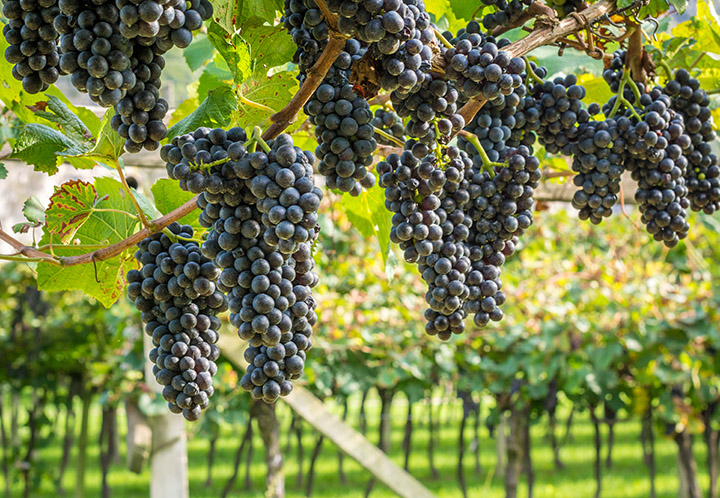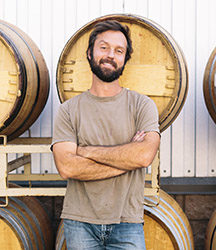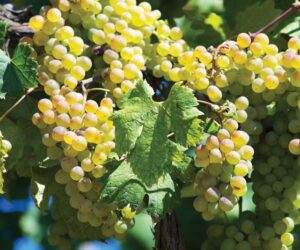One of the most challenging aspects of winemaking isn’t the physical labor or the occasionally tedious chemistry, but the patience involved in allowing a wine to age and mature to its full potential. I’ve judged a myriad of wines where my feedback has stated, “Allow this to age a few years to taste its full potential.” Over time, tannins will form longer molecular chains and be perceived as silkier on our palates. The sharper acidic fruit flavors will soften to jammy notes. It is the winemakers’ plight to not open a bottle before its time and allow the wine to mature. But what if there was a varietal that had rich complex flavors, softened acidity profile, and smooth, easy-drinking tannins after only a year of maturation?

Allow me to introduce you to Teroldego. Teroldego is also known as Merlina, Teroldego Rotaliano, or Teroldego Crni in various areas around Italy and Europe. Teroldego is a Vitis vinifera variety that is native to the northern slopes of Italy. It is most popularly grown in the Trentino-Alto Adige region of Northern Italy near the Alps. This area has a heavy Germanic influence due to its long and complex history and key location at the foot of the Alps. The name Teroldego is thought to be derived from the area Alle Teroldege in northern Italy, where Teroldego grapes have been documented as part of the wine trade as far back as 1400 A.D. Genetically, Teroldego is a full sibling to the ancient French variety, Dureza, which is a genetic parent of Syrah.
In the Vineyard
The influence of the different languages and cultures are not only seen in the variety of names for the grape but in its varying trellising systems as well. The most common trellising system utilized for Teroldego is the VSP, or vertical shoot positioning, system. This allows for good airflow throughout the canopy and for excellent sunlight proliferation through the canopy if leaf pulling and shoot thinning are also part of the viticultural practices. The cooler climate at the base of the Alps can often limit the growing season and can prevent the grape from achieving full ripeness. In this climate, Teroldego is utilized for red wine production, but in years where sugars are lower and acids still high, it can be a component of sparkling wines. This variety tends to flourish on southern facing slopes, where it can soak up the most sun exposure. Teroldego is translated to “little sour one,” which reflects its struggle on its path to ripeness in this area. Italy grows nearly 1,000 acres of this grape, one of the myriad of stunning wine grapes within Italy’s holdings.
Teroldego is now also grown around the world, in places such as Australia, California, and New York’s Finger Lakes region. It is gaining popularity in drier, warmer areas of California due to its natural ability to retain acidity while ripening and its dark and rich pigmentation. It has found its place as a single varietal and as a workhorse in red blends, lending acidity and rich color. Teroldego has also made its way to the East Coast of the United States where many classic vinifera may struggle due to low temperatures and high humidity. Growers and winemakers have long embraced hybrid varieties and non-traditional vinifera to flourish in their unique micro-climates, though Teroldego has been successful in some of these areas.
Teroldego thrives in sandy and gravelly soils that are common in mountainous areas. They also prefer alluvial soils that are the result of ancient streams and rivers flowing down from the Alps. As the water flows down the mountainside, it picks up substantial amounts of organic matter in the form of rotting plant material and various mineral deposits, creating a richer nutrient load within the still sandy and porous soils. This is advantageous for grapevines by providing excellent drainage but also high nitrogen availability due to the organic matter.
The clusters of Teroldego are rather tight, like a lightly clenched fist, which can lead to Botrytis development in wetter years. The grapes can also lose their strength on the vine due to their slightly thinner skins. On a windy site, Teroldego grapes may be blown off the vine while waiting for them to ripen. While these factors may be frustrating to the grower, proper spray applications can stave off Botrytis and knowing your site’s unique climatology can prevent the heartache of lost grapes. Utilizing netting and even laying pick bins out under the trellis while picking or during a storm may help to collect grapes and avoid additional losses due to high winds.
In the Winery
Teroldego grapes create deeply pigmented wines. It is often a small component of many Italian blends solely for its color contribution. When vinified on its own, Teroldego has bright and lively flavors of cranberry and pomegranate with tart red cherry notes. It will also have spicy undertones of baking spices such as cinnamon, allspice, and pepper. Its bolder fruity flavors are due to its higher levels of acidity that it maintains throughout the ripening process, yet its lighter tannin content helps the wine avoid an overly astringent character. This is the main factor that helps Teroldego be consumed at a young age. The tannins aren’t incredibly overwhelming naturally, so no need for a few years of aging to soften them. This isn’t to say that the wine lacks structure or mouthfeel. Instead of the rough phase that many wines go through in their first year of aging, Teroldego steps into the limelight more immediately, with its longer, silkier tannins gracing the palate at a younger age. Consider it “mature for its age.”
Due to its complexity of flavors — bold acidic fruits and rich notes of baking spice — winemakers in Italy tend to not overly oak the variety. Aging in neutral or second use barrels will add the micro-oxidation and reduction to create a fuller mouthfeel without adding intense tannic character that would require more aging time. At the home winery, careful bench trials should be conducted with oak chips or cubes if the winemaker chooses to add oak flavoring. Keep bench trials in a range of 1–2 g/L to start, as to not overwhelm the fruit with excess oak character. Oak spirals or staves may also be a good choice for the home winemaker, but sample the wine often while oak aging to prevent over infusion of oak flavor. You may also consider boiling the oak alternative for 10 minutes prior to adding it, which will diminish the flavor contribution of the oak on the wine. French oak is an excellent choice for this variety, with its finer grains and more gentle tannins. The mocha and caramel notes from the French oak mingle deliciously with the red fruit and baking spice, creating a berry pie-like character.
When selecting a yeast strain, it may be helpful to first know the acidity levels of the incoming grapes. For higher-acid vintages, a winemaker may consider using a strain such as 71B to help reduce some of the malic acid at fermentation. In years where full Brix development may be lacking, I would suggest using a yeast strain such as CSM to reduce vegetal characteristics. The beautiful spicy finish that the wine is known for may manifest more green, herbaceous flavors in poor ripening conditions. In good growing years, achieving a Brix development of 24–26, yeast strains such as Alchemy IV, BM 4×4, Fermivin MT48, and ICV GRE are all excellent at enhancing the red fruit character, diminishing green notes, and enhancing the mouthfeel for an early-to-market-style red wine. These yeast strains along with appropriate doses of a glutathione-based nutrient such as Booster Rouge during fermentation will help maximize the spice and herbal aromatics that the variety is known for.
Not only is Teroldego a faster grape to turn around into a finished wine, it is also incredibly food-friendly. Its higher acidity and complex flavors lend a superb palate cleansing attribute. This wine is delicious when paired with northern Italian- and German-influenced cuisine, from the region which it is indigenous. This area of Italy is famous for its production of speck ham — a ham that is cured with bay leaves and juniper berries, resulting in a strongly spiced, aged ham. The spicy flavors of Teroldego play beautifully with the smoky and earthy flavors of the cured meat. Its bracing red fruit character is refreshing and tasty when paired with dumpling and spaetzle dishes as well as German schnitzels. The jammy red fruits brighten up game-based dishes such as lamb or venison, with the acidity and herbaceous notes holding up to the stronger game flavors. I enjoy the supple tannins and refreshing quality of the wine with a large charcuterie spread and a green, herbed salad when entertaining. The clove and baking spice notes are a great match for stronger flavor profile cheeses such as an aged cheddar or Parmesan, and the supple tannins will be very pleasing with slices of mortadella or prosciutto. The bitter greens and herbs in a salad hold up well to the pomegranate and cherry flavors and are complemented by the subtle herbaceous notes.
Sometimes it’s fun to break out a wine variety at a dinner party not everyone is real familiar with. This is a wine that can be a fun point of discussion and education with even the most selective oenophile in your social circle.
Teroldego Recipe Yield 5 gallons (19 L)
Ingredients
125 lbs. (57 kg) Teroldego grapes
Potassium metabisulfite (KMBS) powder and citric acid powder
5 g yeast (BM 4×4, ICV GRE, CLOS, or 71B)
Liquid pectic enzyme
7.5 g Go-Ferm Sterol Flash
7.5 g Fermaid O
5 g Fermaid K
5 g Opti-Red (optional but helps)
5 g Booster Rouge (optional)
5 g oak dust, French medium+ toast
Wyeast MLF bacteria pack
Distilled water
Table sugar (if Brix is low)
French medium oak chips, cubes, staves, or spirals
Equipment
Crusher/destemmer
Wine press
15-gallon (57-L) fermentation bucket
5-gallon (19-L) carboy
Airlock and bung
Auto-siphon and tubing
Stir paddle
Spray bottle
pH meter
Hydrometer
Spoon and small mixing bowl
Thermometer (digital preferred)
Step by step
1. Ensure all your equipment is clean and in proper working order. Make a fresh batch of KMBS sanitizing solution using 1 Tbsp. KMBS powder and 1 Tbsp. citric acid mixed into 1 gallon (3.8 L) of clean water. Fill a spray bottle with the solution and spray down your processing equipment, but ensure there is no pooling of sanitizer in bins or press basins.
2. Crush and destem grapes and transfer immediately into a sanitized 15-gallon (57-L) fermenter bucket.
3. Add 50 ppm of KMBS to kill off natural yeast. Utilize the sulfite calculator at www.winemakermag.com/sulfitecalculator to assist in your calculations. Throw a cover on the must bucket and allow to sit overnight in a cool area. This will kill negative microbes and allow the must to come to a temperature of 60 °F (16 °C).
4. Twelve hours after the addition of KMBS, add five drops of pectic enzyme per gallon (3.8 L) of must and stir well. Add the oak dust and stir well.
5. Take measurements of your juice, including volume, Brix, pH, and titratable acidity (TA). Adjust the juice to a starting Brix of at least 24, a pH of
~3.5, and TA of 6–7 g/L. Utilize tartaric acid if needed to increase acidity.
www.wineadds.com has helpful calculators for adjusting acidity in must.
6. To prepare the yeast, warm up 50 mL of distilled water to 60 °F (16 °C) and add to the mixing bowl. Then add the Go-Ferm Sterol Flash. Stir well. Then add five grams of yeast and stir well. Allow to sit for 15 minutes. Then mix in thoroughly to the juice with a sanitized stir paddle.
7. Loosely place a lid on the fermentation pail and wait 24 hours to observe yeast activity. Take Brix measurements twice daily via a hydrometer to ensure the start of fermentation. When obtaining samples for Brix measurements, strain the solids out of the sample using a sanitized strainer and pour the liquid into your hydrometer jar or beaker. Using the thermometer, take temperature measurements daily. Try to keep the fermentation temperature between 70–85 °F (21–29 °C) to help secure color but also avoid off-aromas.
8. After one or two days of fermentation, check the Brix. When it has dropped by one or two degrees, add 100 mL distilled water to a bowl with 7.5 g Fermaid O and the Opti-Red and Booster Rouge if you choose to use those items. Mix well to create a slurry and then stir into the fermenting juice with a sanitized stir paddle.
9. Continue to monitor Brix and temperatures daily (twice daily would be preferred). When the Brix has declined to between 15–11 °Brix, add the Fermaid K in the same way you added the Fermaid O.
10. With the temperature between 75–80 °F (24–27 °C) and the alcoholic fermentation well underway, pour the Wyeast MLF packet over the must. Stir to punch down the skins and incorporate the bacterial cultures.
11. Continue to ferment as close to 80 °F (27 °C) as possible until the wine has fermented to dryness (-1 to -2 °Brix). This should take 7–21 days.
12. When the wine has achieved dryness, press out the wine in a sanitized press and pour all of the wine into a 5- or 6-gallon (19- or 23-L) carboy to complete MLF. Make sure to affix a bung and airlock to prevent oxidation and allow the MLF to off gas.
13. After 5–7 days, rack off the lees into a sanitized carboy. Affix a bung and airlock and allow to sit for a month. If you have an air gap after racking, either top off with a complementary wine such as Pinot Noir or add sanitized glass marbles to displace the headspace.
14. Monitor the MLF via paper chromatography or measure the reduction of malic acid via a meter to track the progression of the fermentation. When the MLF is complete, rack the wine and add 50 ppm of KMBS.
15. One month after the initial racking and addition of KMBS, rack it again into a sanitized carboy and add another 50 ppm of KMBS. Consider degassing at this point, briskly stirring with a wine whip during a racking session. Always be careful when using this tool in a glass carboy. Consider racking it into a food-grade bucket for degassing.
16. While the wine is aging, consider the addition of oak chips, cubes, staves, or spirals to add a bit of oak to enhance the wine. This variety is complemented by oak but be wary to not over-oak it and overpower the robust fruit that Teroldego is known for.
17. Allow the wine to age, maintaining a free SO2 level appropriate for the pH. Use the sulfite calculator to determine the proper dosage given the parameters of pH and volume. You can filter the wine after eight months of aging if you choose. At this point, it should have been racked about four times and have completed its oak aging.
18. You may want to consider cold stabilizing or acquiring a cold stabilizing product such as Zenith Color. This product may only be used if the wine is filtered down to 0.5 micron as turbidity will interfere with its effectiveness.
19. Once cold stability has been achieved via physical or chemical means, taste the wine and consider if it is ready to bottle. Fining agents such as Super Kleer or mouthfeel enhancers such as gum arabic may help improve mouthfeel and clarity.
20. Bottle wine once you are content with the flavor and stability. Add sulfite before bottling — 10 ppm beyond the sulfite calculator’s recommended value — to account for oxygen uptake during the bottling process.






